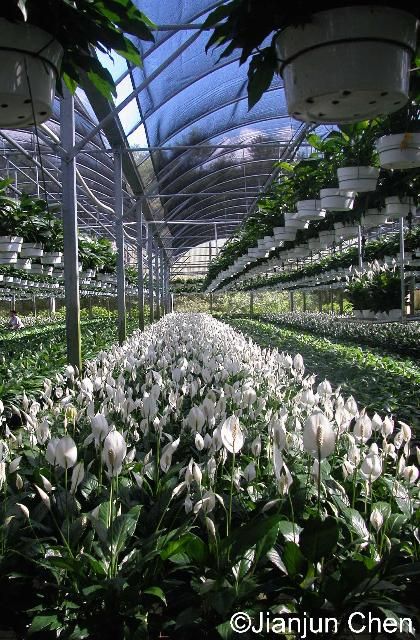Spathiphyllum, commonly known as peace lily, is one of the top selling plants in the Florida foliage plant industry. Peace lily thrives and produces attractive dark green foliage year round even in the toughest interior conditions. However, it is the showy white spathe and spadix "flowers" that delight consumers (Figure 1). To sell best, spathiphyllum needs to be in bloom.

Credit: Jianjun Chen, UF/IFAS
Twenty-five years ago, having marketable spathiphyllum in bloom required producing plants in large containers to mature size, at which time they would flower naturally. It often required a commitment of over a year to produce this mature crop. The flowering event was limited to spring and early summer months; having flowering spathiphyllum in the fall was out of the question.
Despite this seasonal market limitation, spathiphyllum grew in popularity and led early plant breeders to attempt to develop new cultivars. Breeders, however, were hampered in their work by the lack of year-round flower availability. Cross pollinations could only be done 3 to 4 months out of the year while the natural flower cycle was active.
In the early 1980s, researchers at the University of Florida in Apopka seeking to increase flowering for breeding opportunities, discovered that spathiphyllum could be induced to flower with a single foliar spray of gibberellic acid. Gibberellic acid (GA3) applied to spathiphyllum initiates flower buds and produces flowers 70 to 110 days later. This induction using a naturally occurring plant hormone is not dependent on time of year or temperature.
Within the next twenty years, over 40 named spathiphyllum cultivars were developed by breeders and became available to consumers. Spathiphyllum growers dramatically improved market share by shifting the crop from a traditional foliage crop to the year-round flowering potted plant category. Gibberellic acid treatment allowed growers to sell smaller pot sizes in bloom.
There were some drawbacks, however, in response to gibberellic acid treatments. Even allowing for variety variation, a percentage of the flowers were distorted. Some spathiphyllum varieties stretched unacceptably. New foliage treated chemically was extremely narrowed with a strap leaf shape. Around the same time, growers were faced with rising chemical costs, and consumers were raising environmental questions. This lead to the question: "Is there a non-chemical way to induce flowering of spathiphyllum year round?"
Researchers revisited factors present during natural flowering of spathiphyllum cultivars. The ability to stimulate non-chemical-induced flowering of spathiphyllum involves: 3 parameters 1) photoperiod, 2) temperature, and 3) plant factors, including age/maturity and cultivar genetics.
Photoperiod Factors
Spathiphyllum that bloom naturally in spring and early summer initiate blooms the previous December or January, within the short day/long night photoperiod. Conversely, plants that are not in flower in the late summer or fall do not initiate flower buds during June through August under the long day/short night photoperiod. Thus, a wide range of cultivars was tested by growing in three photoperiods of 8, 12, and 16 hours for flowering induction. However, no particular photoperiod responsive types were confirmed. Instead, three types of flowering response were identified:
- Age-dependent type: cultivars flower continuously after reaching a specific age or maturity. Identified hybrids include 'UF474-1', 'UF576-14', and 'UF545-98'.
- Season- and age-dependent type: cultivars flower after reaching the species-particular age and flower only during spring and early summer. Most cultivars including 'Petite', 'Tys Pride', and 'Viscount' are in this category.
- Cross or multi-seasonal type: cultivars will flower more than once during the year. Identified cultivars are 'Connie', 'Little Angel', '5598' and 'Mini'.
Temperature Factors
Growth chamber experiments were also initiated to study temperature effects on flowering. Preliminary results from ongoing tests show that the optimal air temperature for season- and age-dependent spathiphyllum types is 22°C (72°F). Plants that undergo a chill of 12°C (54°F) can flower 3–4 weeks earlier than those not chilled. At this time, research can only be applied on small plant units from tissue culture. The high initial investment necessary for the cost of treatment chambers and the increased energy and labor costs to operate chambers make chamber chilling an impractical alternative to chemical treatment for the average grower.
Plant Genetic Factors
Although the literature contains no information regarding the genetic background of Spathiphyllum, the range of flowering responses indicates that interspecific hybridization has occurred somewhere in the genealogy of these cultivars. It is apparent that sufficient genetic variability determining Spathiphyllum flowering response to GA3-treatment exists to allow breeders and growers to compare cultivars based on differences in number of flowers, flowering time, and flower quality. In the future it is probable that several spathiphyllum cultivars will be developed that are insensitive to environmental factors affecting flowering. These plants will flower continuously once reaching maturity—similar to their close relative Anthurium.
Thus, it is not yet cost effective for growers to stimulate spathiphyllum flowering using environmental manipulation (see comparison in Table 1). For dependable timed flowering of spathiphyllum, it is still necessary to rely on use of gibberellic acid sprays. GA3 treatment is relatively easy and effective, but producers should always test any new cultivars on a small scale before treating large production blocks.
Flowering induction research has focused on fine-tuning gibberellic-acid induced flowering techniques. Studies are looking at using ultra-low dose concentrations of GA3, application timing, and treatment of youngest possible plants.